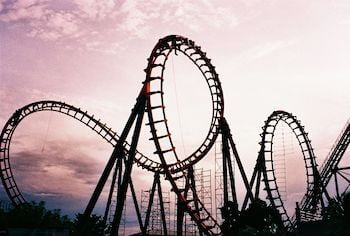T
It's a good headline, JP, that's catchy, isn't it? How did we actually at Kingfisher consolidate stock and save 35%? My name is T. My background is in supply chain software. At Kingfisher we use SAP F&R and have done implementations here for different systems, but also project management, training, basically the whole cycle of implementation, all the way from the beginning till the end.
About Kingfisher, I think we like to present ourselves as the largest DIY retailer in Europe. We have about 70,000 people working for us globally and we have a total of seven banners…eight, if you also include Turkey, where we have a joint venture. We have five regions. In the UK, we have B&Q and Screwfix, in France we have Castorama and Brico Depot which is also in Iberia: Spain and Portugal. We have another Brico Depot in Romania and we have Castorama in Poland. All of these companies we call banners. Every banner has its own directors, its own board, its own infrastructure in terms of managing commercial sales, managing their stores and they also have their own power because of this, Kingfisher’s strategy is “powered by Kingfisher”.
We're powering the banners to be the best that they can be. Taking a step back, we're actually generally speaking an SAP company. All of us are using EC6, apart from Screwfix and Brico Depot France. Brico Depot France is going live later this year. Now this is very important to remember because it becomes more evident why this is challenging later on. Despite the fact that the banners all have the same system, they are all using the supply chain and other tools differently. Varying levels of maturity across the group and also in their planning process. As I said, we're using SAP F&R across the group. However, Screwfix uses XXX. Currently Brico Depot Iberia are using a custom built tool called XXX, which they're very happy with and they've somehow had to build an infrastructure around it so that they could work with XXX.
For the rest, everyone's basically using SAP F&R which is a forecasting and replenishment tool. It's a weekly forecasting tool that I think has evolved from the SAP purchase of a Swiss company 10 / 15 / 20 years ago when they developed it and it's one of the tools that will run out of support in about five to seven years time. I work in the Supply Chain Centre of Excellence. If you remember “the powered by Kingfisher”, it's a supporting function for our banners that can help them implement software and other projects. We work together with the banners and we also have a central reporting function with KPIs across the group and that provide a very high level overview of how the supply chain and the logistics networks are performing.
M
Just to confirm T, every banner has their own supply chain organisation set up operational?
T
Yes. They all have their own analysts. They all have their own supply chain directors. They all have their own function basically. They don't really overlap, there's not that much in terms of lessons learned or anything currently apart from the research projects that we’ve done in the past. There's not that much overlap in terms of strategy.
M
And you might be coming onto this. What degree is the portfolio shared across the banners?
T
I will get into that but that's basically the main reason why we're doing this project and why we've saved 35%. So we have been thinking about wholesale. For Kingfisher to become a wholesaler and to centralise certain purchasing for years and years because as there's trends of centralization and decentralisation, they come and go every five or ten years. Kingfisher is not special in that. We've been thinking about it for years. We've had projects set up in the past, never really got around to doing it. That's why we have now set up the European Consolidation Centre. In December 2020, the European Consolidation Centre project was approved and this is a very new venture, so you'll see that it won't be very slide heavy, but this is probably quite a good one to show where actually the previous state on the left is basically you have a lot of different vendors supplying into the different banners…B&Q, Screwfix, etc.
Also then for the banners to deliver it into the stores. Now that was, at the time, the decentralised state. Banners are purchasing directly from the vendors means that you're holding seven times or banner times different safety stocks, you're also holding a lot of other cushioning stock because the forecast accuracy actually on banner level currently is about 50% so you need to hold a bit of extra safety stock for that as well. The proposed state is basically consolidating all of the demand and order forecasts from the banners into the ECC. The ECC would purchase the goods centrally and would ship them out as soon as the goods come in. So “KIPL” is the new Kingfisher entity that owns the stock, which has never happened before. Kingfisher never owned any stock.
We only focus on far sourced products and M, as you say, we also needed to focus on own and exclusive brands, what we call the Kingfisher brands. McAllister, for example, or Magnusson and Verve for the garden products. If you've been to B&Q, these are products that are owned by Kingfisher. Good Home as well, is one of the brands. The banners have their own choice of whether they want to stock these products in their stores because they have their own autonomy, which makes it more complicated, but there is definitely some level of range similarity. That's why, in order to centralise it, we wanted to bring that all together. When we were looking at locations, we focused on logistics service providers and went with XXX, based in Tilburg.
We don't have any banners in the Netherlands, but it seemed to be the best place to have our European Consolidation Centre. We wanted it to start small. As with a lot of good things and proof of concepts, you need to start small in order to see whether it will work. The 350 SKUs we started off with, some with range commonality, some not, but basically the idea was to be able to scrutinise the demand forecast from the banners, review it, import it into a system and then look to purchase centrally. I had to look at the planning tool market and look at solutions for this European Consolidation Centre.
I had conversations with most of the tools on this slide and started to work with a few proof of concept ideas. XXX was one of them. That would have cost about double the cost of this entire proof of concept. So that was out…we didn't want to use that. XXX came in because they are a retail favourite, but because this is not necessarily a retail project, they were out as well. XXX would have been a very good option for us as well, but again, it was going to be slightly too expensive. We started thinking about what do we actually need? All we need is to get the forecasts from our banners and consolidate it into a system so we could purchase centrally. F&R would have been an option because would have been the perfect option if Screwfix and Brico Depot of France were already on SAP F&R, but they're not.
If we had to implement F&R in the current state, without them being on F&R, we’d have to manually alter the forecast inside F&R, so that wouldn't have been an option. We started looking at off the shelf planning tools and there are three quite big players XXX, XXX and XXX. XXX didn’t think that they could really help us. However, XXX and XXX were quite responsive and actually we ended up going for XXX because they had the best UI for us and they ticked all of the boxes in terms of functionality and they were also very affordable.
M
Just to understand the scope of what you were looking at in the supply chain: when you talk about forecast, are you right out at the sell out from store end of the supply chain? Considering stock in your stores, given some of your locations and knowing some of the massive Screwfix’s and B&Qs that we have in the UK, for example? Was it stock in stores and stock in the DC or was it just DC to store selling?
T
So it's a good question. If you see here, the proposed state would have been stores being supplied by the DC, the DC being supplied by the ECC and the ECC being supplied by the vendors. In this scope, we were not counting the stock in the stores, but in order to have visibility, we did want to see the stock in the DC's on banner level and on SKU level, and of course also the stock in ECC level because that's what we needed to plan our inventory.
M
Okay, so the signals that you're looking to consolidate are the replenishment signals aggregated up from each of the stores?
T
Yes. Also the banners…it was the banner's responsibility to supply us with the order forecast that they were going to order from us to manage their stock. So we would still have visibility of their stock level and also of their total sales on banner SKU level. We knew how much they sell and how much they thought that they were going to purchase from us. We could have an overview of if what they were saying was sensible, or potentially, if it wasn't sensible, we would be able to review it with the banner. Because if you remember from earlier, I said that the forecast accuracy was 50% on banner level. Now, if your forecast accuracy on a single banner level is 50%, an aggregated view of your forecast is automatically going to be better. If a lot of banners have 50% forecast accuracy, actually, what we found is that the total forecast accuracy for the group was more around 70% to 80% because an aggregated forecast is better than just a single forecast.
That was one of our main benefits that we found. Before jumping into that, the main scope was to have the DCs and the ECC in our planning tool and for the planning tool to be able to ingest the forecast and also aggregate the forecast on line level, on SKU level, basically. Every month we'd get an Excel file from the banners for the 350 SKUs that are in the ECC saying this is how much we're going to purchase from the ECC in the next twelve months. The XXX tool seemed to be the most appropriate and we got that over the line in March last year. Of course, XXX is a tool that requires a certain file layout, so they're not flexible in terms of I'm going to put my master file here, I'm going to put my PO file there. They have a very specific layout, which is great because then we just tailor our file structure to them and they don't need to tailor their software to us.
We found that to be quite a big benefit. That did mean that we had to set up a server. Despite the fact that it's a SAP solution and it's in the cloud, we still had to provide them with the server so that we could access XXX from the cloud. XXX was set up in literally a few months and in June / July we were ingesting the first data with stock coming in August and September into the ECC. We had to place some manual orders before XXX was live, unfortunately, but that was done quite well. With this overview of the tools, are there any questions around the tools or about a way of thinking?
M
There's just one thing going back to the previous chart. Was there any activity going on around swapping stock between the DCs before or even now at banner level?
T
There wasn't but we did have to transfer some excess stock out of a banner in order to fill up the DC. Like a stock sharing, is that right? It's not something that we do standard, unfortunately. There are several projects that are looking at that, but currently it's too expensive and the processes are just not set up that way. Unfortunately, despite the fact that we're all on SAP F&R we’d hope that there might be some easy way out for that but unfortunately not.
M
Yes, I can imagine if one banner is sitting on a lot of stock and another banner is needing to replenish, the trade off decision between is it cheaper to buy fresh stock to service the banner that is low versus transferring existing stock from an existing sister DC? That type of logic, that optimisation.
T
Yes, absolutely. I think there are projects on the way to look into that, but it's still very much in early stages.
B
What governance processes have you put in place to manage the relationship between the central warehouse and the banners because there's now an opportunity for gaming and all sorts of things to go on?
T
Fantastic question, and that brings me to our S&OP process.
As you can see, there are seven different banners, seven different processes, and they all need to combine into one process and it all needs to feed into the order forecast that goes into the system to base our purchasing on that number. Every month, we have meetings with the banners where we would present their order forecast accuracy. That’s with the banner separately and with the analysts all the way up to the supply chain directors meeting which would be separate as well but we would present them with the current stop levels, the current availability within ECC. We would present them with how much they ordered versus how much they received versus how much they forecasted. But because it's seven different banners these meetings have had varying levels of success. Unfortunately, the forecast accuracy still wasn’t great throughout the process.
What we would do in these meetings which would vary from half an hour with the smallest banner to 2 hours with B&Q - the biggest banner - we'd have a staggered approach. We would discuss the exceptions at this S&OP meeting and we would really take them through XXX because F&R wouldn't really be able to give that much visibility on this. It really did a fantastic job in showing the banner how much stock they had, how much they've sold, how much they're telling us that they're going to purchase from us and XXX would actually show exceptions that would help us. For example, we would talk them through their orders versus their forecast and see which SKUs would have the biggest exception and also the other way around. Where they ordered more than they forecasted and also where they forecasted more than they ordered.
We also looked at their excess stocks, so the stocks that they would currently have available and what we thought they already had in excess. We also looked at their future out of stocks and their current out of stocks. Every month we would receive a new file, every month we would upload this file and every week we place orders with our suppliers to see whether that was necessary. I don't know if that answers your question B?
B
I think yes it does in terms of an overview, it sounds like it's a standard S&OP type process. I suppose where I was moving towards was that, in my experience in FMCG businesses, when you're running this type of thing, quite often you get markets who have a relatively low level of maturity just boosting their forecast to secure stocks. They manage their service with very little pain or consequence as the working capital sits elsewhere and they don't really see that impacting their local P&L or, if it does, it comes in at an overhead level so it doesn't drive any change of behaviour. So, slow-moving obsoletes, for example, how are you managing those?
T
We wouldn't have them because we started off with 350 products which were all quite fairly fast moving.
B
Okay.
T
With the over forecasting we’d go through the exceptions, actually having the visibility of their stock levels so we would be able to say, “okay, you actually have 200 days of stock here. If you still purchase this stock from us then you would have 350 days. That doesn't make much sense”. Even in the worst case, if we would be in overstock - because the ECC was quite a small location with quite limited space - we'd have to phone up the banners and say, “listen, you forecasted 2000 pieces, please go and take your 2000 pieces. I'm sorry but you have to take it.”
B
So why not move to almost a VMI type process whereby you are managing replenishment and push it through?
T
Good point. It's like ‘VMI-lite’, I guess. Banners are independent: they decide what they want to do. We had the visibility [within the CoE] and the historical forecast so the best way was to query what they had forecasted based on the information available to us.
Technically speaking with the ECC, you don't necessarily have to push it out because the benefit of it is if one banner is over ordering the other banner is under ordering that cancels each other out [for the same SKU]. That's also why we chose that 350 SKUs because a lot of them would have a two or three banner commonality.
B
If you were to take a runner, repeater, stranger approach…you've done this for your runners. You'd expect to get that throughput…that pull through naturally anyway.
T
Absolutely. The runners, together with the high commonality, were the most important thing for us because if you don't have a high commonality then you might as well not do it because then you're only saving one safety stock. Whereas, if you have those four different banners of commonality you're taking four safety stocks out and you're putting one in.
B
Wouldn't you also see some benefit coming through from your vendors in terms of the reduced complexity of delivery, the delivery to one point, the consolidating load, so the frequency of delivery that you would be able to get will be much higher compared to a disparate view? Therefore, just by that replenishment cycle or opportunity increasing, you can drive stocks down from that perspective as well?
T
Absolutely. That's also the next slide. I was going to talk about the challenges and then the benefits of it as well. So I'll just go to the challenges. For us, what we found during this process is basically that, as we're doing this in 2021, it was a new organisation and we also had extended lead times and delays at the port. Big challenges that we all had to go through. We also couldn't quite get the reduction in cost for transportation and logistics because we're adding a node in the supply chain and also working with another 3PL, despite the fact that the banners were actually saving the cost in terms of stockholding. One of the biggest challenges was getting the banners to order what they forecasted.
Forecast accuracy was also a big challenge for us. So those are the three main ones. I want to add to that the systemic challenges: because we use SAP and we use XXX, there are quite a lot of manual processes in between. The order recommendations from XXX, we had to manually import with all of the other banners. For example, Screwfix are not using F&R so we have to import their orders manually into SAP as well. There are definitely a lot of challenges around that but nothing that can't be sorted by one or two people. The results for us, despite the fact that we had a lot of challenges, group inventory dropped by 63 days compared to the beginning. It was 185 days for those 350 items across the group and the total stock is now 122 days.
M
T, how did that impact availability?
T
It's actually improved. Availability has gone up from 90% to 97%.
M
Perfect.
T
Granted, some of that is also post-Covid recovery but it hasn't gone worse.
B
If you compare that pre-Covid, where does the service level stack up? Because that's the biggest benefit that you'll get, isn't it? If you got 1% increase in sales or something like that coming through, that's a massive benefit.
T
On those lines it stays the same. Pre-Covid is different as well because the demand was cooling.
I think all we can say is that the demand went crazy during Covid…we've had a great few years. Everyone wanted to have a hot tub and everyone wanted to get new paint and spruce up their house. So availability dropped significantly. With the global shortage and the global crises: the wood crisis, the container crisis, everything, when that started clearing, it definitely improved. All I think we can say is that, because of our scrutiny of the planning processes, we identified inefficiencies within the banners and we managed to reduce their inventory by 63 days. Also the banner stock level keeps on decreasing on certain faster moving lines. That's also the benefit of going with the runners is that they will be able to just sell the stock because the slow moving lines in B&Q are very slow moving. The slow moving lines in Screwfix are less slow moving because they have just a faster turnaround of stock.
(Discussion continued into areas that we can't share publicly. We may return to this case study again in future.)




